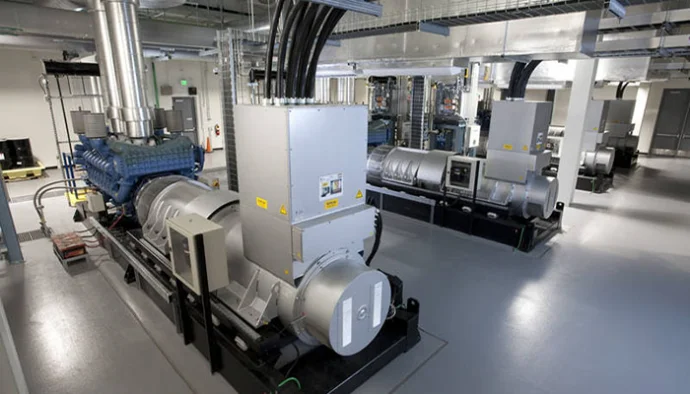Designing Standby Power Generators For Datacentres
Generators provide mechanically generated electrical power by converting a fuel source including diesel, liquid petroleum gas or bio-fuels in electrical energy. The generators we most commonly use within a UPS installation are used on what is known as a standby power mode. The alternative to this is prime power mode where the generator is run continuously. Each type of use must be sized correctly if the generator is to be able to provide the power required, for the runtime required and to provide this for a reasonable operating and working life.
Prime Power and Standby Power Generator Ratings
- Prime Power Rating (PPR): sized for continuous operation for sites with no mains power supply and the most commonly used for use when sizing generators for uninterruptible power supplies.
- Standby Power Rating (SPR): sized for short duration support times as an alternative to the mains power supply. The Standby Power Rating can be 10% larger than that for Prime Power Rating to allow sufficient headroom for overload and sudden demand changes.
Generators are motors and as such are often measured in terms of ‘hours of operation’. This value is a metric that is often used within the second-hand generator market a measure of how long a generator has been used for and its potential remaining working life. It is a similar analogy to a car and the miles the vehicle has travelled. These are indicators of the potential life expectancy of the car engine, clutch and gearbox.
UPS Systems and Generator Sizing
Standby power generators are often used with uninterruptible power supplies where they are designed to provide a long duration runtime. The battery pack within or connected to the UPS system is there purely to cover the start-up period of the generator and provide a potential safety margin if the generator fails to start.
As well as protecting the critical loads, other essential loads may also be powered by the generator during a power outage. Essential loads can include cooling systems, lighting and access controls. These loads do not require the quality and type of no-break supply guaranteed by an uninterruptible power supply but do require a source of standby power when the mains power supply fails.
A typical generator will run-up from a cold-start to full power within a few cycles and in terms of time frame this can be up to around one minute. If the generator fails to start an on-site engineer will have to get to the generator installation and identify the fault quickly enough to rectify it. Typical faults can be a flat generator-starter battery, open isolator (from a maintenance inspection), air bubbles in the fuel lines or contamination of the fuel supply. Generator issues like this be can be prevented through routine generator inspections and monthly start-ups.
For critical sites it may also be a requirement to perform tests using a load bank which imitates the actual load profile and/or to perform a ‘black site’ test that simulates a complete mains power supply failure.
Modern UPS systems (IGBT-based rectifier) and generators generally have very good synchronisation characteristics and use a sizing factor of 1.25:1 (generator:UPS). The generator is 125% the size of the UPS system meaning a 100kW rated UPS requires a 125kW rated generator. This factor can be reduced to 1.1:1 for well match UPS and generator combinations. For generators with older alternators and/or UPS systems which are older and potentially fitted with 6-pulse or 12-pulse thyristor-based rectifiers it may be necessary to use a generator sizing factor of 1.5:1 or 2:1 or higher.
Generator Automatic Mains Failure Panels
One of the key components within a generator installation is the AMF panel. AMF stands for ‘automatic mains failure’. An AMF panel is installed to the same mains power supply as the uninterruptible power supply and monitors this for power outages and instability.
When either of these conditions is observed the load is protected by the UPS system which will use its battery set to power its inverter and protect the load. The AMF panel meanwhile will send a signal to the standby power generator to start-up.
The generated supply is supplied to the UPS system which will attempt to synchronise to this new AC sinewave. Once this is achieved the UPS will use this supply to power its rectifier/inverter operation and recharge its battery.
A generator will continue to operate provided it has fuel. A typical internal fuel tank will be a day tank covering 8 hours of operation. The actual operating period will depend on the load on the generator itself and fuel consumption which is measured in Litres/Hour. External fuel tanks may also be installed and topped up during even during use.
The AMF panel will continue to monitor the AC supply installation and when a stable mains power supply has been restored, will signal the generator to shut down. The UPS system is battery and internal capacitance is again used to cover the transfer from generator to UPS supply.
Other factors that can affect generator sizing including ambient temperature and altitude which can lead to the need for derating. Generators are typically installed outside of a main building and care must therefore be taken here. The generator may be installed in a specially designed outside building or container or be placed outside with only an external canopy for protection. This would be what is termed a ‘weather-proof’ canopy that also provides noise attenuation. A heater-blanket (electrically powered) may also be installed to keep key components warm, as well as other frost protection systems.
Summary
Modern generators, if well maintained and inspected are very reliable. To increase their resilience, it is common practice in a datacentre environment to install them in an N+X redundant configuration upstream of the UPS systems. This may be a necessary requirement if the datacentre installation is to be certified to a Tier-rating by the Uptime Institute (More information: https://uptimeinstitute.com/).


























